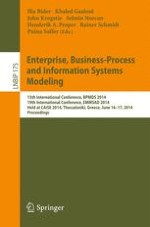This book contains the refereed proceedings of the 15th International Conference on Business Process Modeling, Development and Support (BPMDS 2014) and the 19th International Conference on Exploring Modeling Methods for Systems Analysis and Design (EMMSAD 2014), held together with the 26th International Conference on Advanced Information Systems Engineering (CAiSE 2014) in Thessaloniki, Greece, in June 2014.
The 20 full papers accepted for BPMDS were selected from 48 submissions and cover a wide spectrum of issues related to business process development, modeling, and support. They are grouped into topical sections on business process modeling as a human-driven process, representing the human perspective of business processes, supporting humans in business processes, variability-enabling process models, various models for various process perspectives, and BPMDS in practice.
The ten full and three short papers accepted for EMMSAD were chosen from 27 submissions and focus on exploring, evaluating, and enhancing modeling methods and methodologies for the analysis and design of information systems, enterprises, and business processes. They are grouped into sections on conceptual modeling, requirements modeling, business process modeling, goal and language action modeling, enterprise and business modeling, and new approaches.
